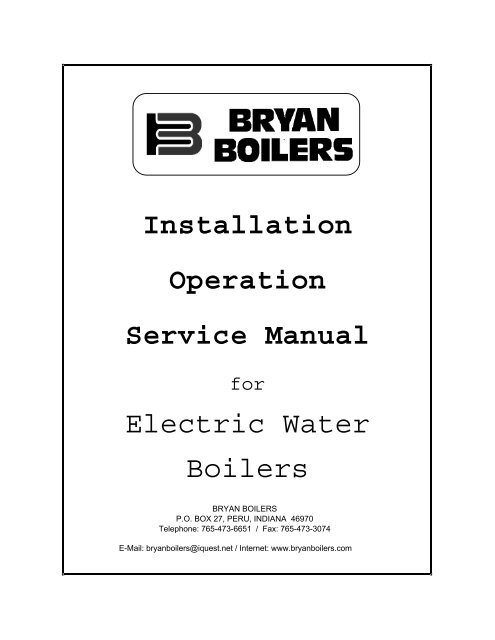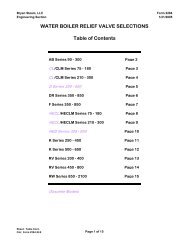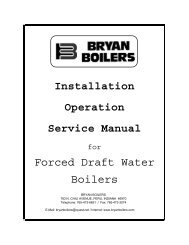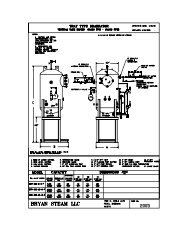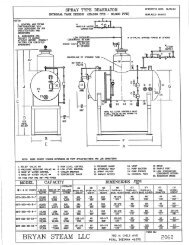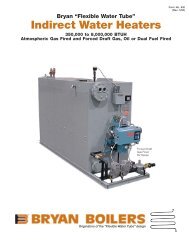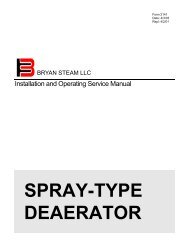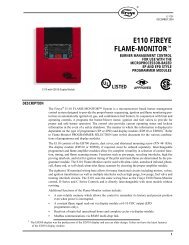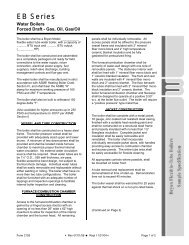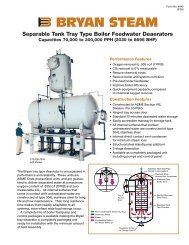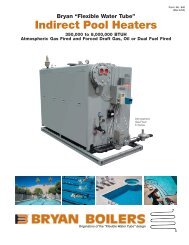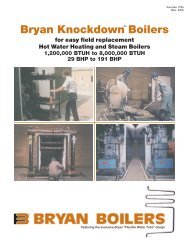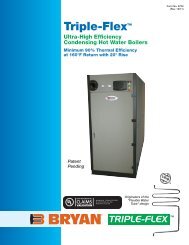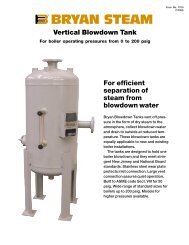Electric Water Boiler - I/O Manual - Bryan Boilers
Electric Water Boiler - I/O Manual - Bryan Boilers
Electric Water Boiler - I/O Manual - Bryan Boilers
You also want an ePaper? Increase the reach of your titles
YUMPU automatically turns print PDFs into web optimized ePapers that Google loves.
SECTION 1 INSTALLATION INSTRUCTIONS Date: 10/1/97FORRevision: NewELECTRIC WATER BOILERS Form: 2056-1NOTE:? Please read the entire instruction manual before attempting installation.? Insurance, Local and/or State regulatory codes may contain additional or more stringentrequirements than those contained in this manual. Installation must conform to these codes andany other authority having jurisdiction.? Appropriate sections of NEC should be consulted and followed.1.1 BOILER FOUNDATIONBefore uncrating, the boiler location should be prepared. The boiler should set upon a good levelconcrete floor. If the boiler is not level or the floor in good condition, a concrete foundation should bebuilt, utilizing dimensions larger than the outside dimensions of the boiler base.1.2 CLEARANCESThe front of the boiler should not be any closerthan 36" from any obstruction for servicing theelectrical panels. The element end of the boilershould not have any obstruction to allow for thesame length as the boiler supplied for removaland servicing of elements. The back of theboiler (as long as panels are not supplied in therear) can be mounted next to an obstruction.Local codes must be applied to specific1.3 UNCRATING THE BOILERUncrate the boiler near its permanent location.Leave it on the bottom crating until ready toplace permanently. Leave the plastic shroud onthe boiler until all piping work is complete;cutting holes in the plastic for access toconnections.installations and the minimum clearancesestablished accordingly. Provisions must alsobe made for service, accessibility, andclearance for piping and electrical connections.NOTE: ADHERE TO ALL APPLICABLE LOCALCODES AND NEC REGARDING BOILERINSTALLATION AND CLEARANCES.Remove the bolts attaching the boiler to thecrate at the underside of the bottom crating.Lift or slide the boiler off of the bottom cratinginto position. Be careful not to tip the boiler upon one corner or side, which could causedamage to the jacket.
1.4 BOILER CONNECTIONS1.4-1 GENERALDo not run any pipes along the element accessand power panel side of the boiler. Maintainclearances as shown on the dimensionaldrawing for servicing and as referenced inNEC. All piping should be designed andinstalled to avoid any loadings on the boilerconnections or piping.1.4-2 FLOW CONNECTIONSThe system supply and return flow connectionsare shown on the boiler dimensional drawing inthis manual. A gate valve and union should bein the boiler outlet and inlet lines. This allowsthe boiler to be isolated from the heatingsystem for draining and servicing. Use a tee,nipple, and cap on the boiler inlet line to allowinspection and cleaning.1.4-3 SAFETY RELIEF VALVE(S)A connection is provided in the top of theboiler for the relief valve. The relief valvedischarge piping must be the same size as therelief valve discharge opening. Avoid overtighteningas this can distort valve seats. Allpiping from relief valve must be independentlysupported with no weight carried by the valve.1.4-4 EXPANSION TANK CONNECTIONA connection is provided in the top of theboiler for connecting piping to the expansiontank. This piping should be installed as to avoidair entrapment in the boilers.1.4-5 DRAIN CONNECTIONA drain valve must be installed off of the boilerdrain connection, the same pipe size as thisconnection, to allow draining the boiler.1.4-6 INDIRECT WATER HEATING BOILERSWhen the boiler is to be used only for heatingpotable (domestic) water or swimming poolwater, the heating system connectionsdiscussed above are capped. The relief valveconnections are still required. <strong>Water</strong>connections are made only to the indirect heatexchanger(s), according to the piping drawingincluded in this manual. An automatic boilerfill valve is provided with the boiler. This valvemust be connected to the fresh water system.With some units, this connection is made to theheat exchanger at the factory.1.5 ELECTRICAL CONNECTIONIMPORTANT: All electrical connections mustconform to the NEC and to all other applicableState and Local Codes.The heating elements supplied with <strong>Bryan</strong>electric boilers are of the resistance type withan incoloy sheath and a watt density notexceeding 75 watts/square inch. Theseelements are typically delta wired unlessotherwise specified. Power supply voltage mustbe as shown on the wiring diagram enclosed. Afused main disconnect switch must be suppliedper NEC requirements.Wiring to the main power terminals in thepower panel by the contractor must havecurrent carrying capacity equal to at least 125%of the amperage rating of the boiler. The lugssupplied are at the top of the power panel andthe entrance can be recognized on thedimensional.EQUIPMENT GROUNDING: The boiler must begrounded in accordance with the NEC,ANSI/NFPA #70-1981.
CAUTION: ALL CONTROL PANELS AND CONTROLS ARE SUBJECT TO SOME INTERNAL HEAT.ADEQUATE BOILER ROOM VENTILATION MUST BE PROVIDED.1.6 BOILER ACCESSORY EQUIPMENT1.6-1 ELEMENTSThe immersion type electric resistance heatingelements are mounted in a standard 150# flange(300# flange if required). These elements areheld into this flange with brass fittings. Eachelement hairpin is rated at 5 KW or 10 KW atthe rated volts. The incoloy sheath is a nickel,chrome and iron alloy, which provides goodresistance to oxidation and has good strengthcharacteristics at elevated temperatures. Byvirtue of its very high nickel content, thematerial does not have a tendency to becomeembrittled after prolonged exposure totemperatures. Corrosion resistance of theincoloy is attributed to the chrome and nickelcontent of the alloy. This type of material waschosen as a sheath material because of itsresistance to corrosion oxidizing conditions andattacks from impurities in the various waterconditions. Each element is easily replaced byusing ordinary hand tools. This eliminates thenecessity of having a complete element bundleas spare parts and also eliminates the necessityof returning the element bundle to themanufacturer for repair, although this service isavailable.1.6-2 BOILER COMPONENTS - GENERALThe boiler equipment list in this manual liststhe components supplied with this boiler. Adescription of the major components follows,however, detailed information can be found ineach manufacturers literature data.1.6-3 POWER PANEL WIRINGThese circuits are broken down into branchcircuits of no more than 50 amps per circuit. Adistribution lug in the BE Series and a copperbus bar in the BH Series is used to branch thepower to individual fuses and contactors inThe safety relief valves are mounted on the topof the boiler. These are a final safety device ineach branch circuit. Each leg in each circuit isindividually fused with fast acting fuses tointerrupt power if required. The contactors arethen wired using high temperature wire to eachelement circuit and bundle located in theelement flange.1.6-4 CONTROL CIRCUIT WIRINGThe control circuit voltage is 120 V, singlephase, and fed from a step down transformer (ifprovided). The transformer=s primary side isconnected to two fuses located in the powerpanel. One side of the secondary is groundedand the other side feeds the control circuitthrough the control circuit fuse. All of thesafety controls are wired in series so that anyone of the safety controls will shut down theboiler if the limit is reached. Also, located inthe control circuit a recycle relay (in somecases the relay is built into the sequencer). Incase of power failure, the function of this relayis to eliminate a sudden power load on thedistribution system. If a power failure occurs,the recycle relay interrupts the control circuitpower causing the magnetic contactors to dropout. Power is shut off to the elements until themodulating motor has driven the sequencerback to its original starting position. The relayis then activated, and the sequencer will bringthe steps back on one at a time until the systemis again balanced. There is also a limit suppliedto be installed with the shunt trip on the maincircuit breaker in order to completely shutdown all power to the boiler. Refer to theelectric wiring diagram supplied.1.6-5 SAFETY RELIEF VALVEScase the operator and other safety devices fail.Such a failure will cause the pressure to rise in
the boiler to the set pressure of the relief valve.The relief valve will discharge, so that theboiler will not be able to generate pressurebeyond the set pressure of the relief valve.1.7 PROCEDURES TO BE FOLLOWEDBEFORE PLACING BOILER IN OPERATION1.7-1 HYDROSTATIC TEST OF BOILERS &SYSTEMAfter completing the boiler installation, theboiler connections, fittings, attachments andadjacent piping must be inspected for leaks byfilling the unit with water. The pressure shouldbe gradually increased to a pressure just belowthe setting of boiler safety relief valve(s).1.6-6 LOW WATER CUT-OFFThe function of the low water cut-off is to shutdown the boiler if for any reason the waterlevel should drop below the normal operatingrange.Remove the boiler access panels (seedimensional drawing in this manual). Inspectall openings and fittings for any leaks.Although the boiler is hydrostatically tested atthe factory, minor leaks in fittings andattachments can develop from shippingvibrations or from installation procedures. It isoften necessary to re-tighten such fittings afterinstallation and after the boiler has been inoperation for some time. Replace panels beforestarting boiler.
Section 2 START-UP AND OPERATION Date: 10/1/97FORRevision: NewELECTRIC WATER BOILERS Form: 2056-2WARNING: IMPROPER SERVICING AND START-UP OF THIS EQUIPMENT MAYCREATESERVICING A POTENTIAL AND HAZARD START-UP TO MUST EQUIPMENT BE DONE AND ONLY TO OPERATORS BY FULLY TRAINED ORPERSONAND S IN THE QUALIFIED BUILDING. PERSONNEL.2.1 LIMIT CIRCUIT CUT-OUT TESTCAUTION: BEFORE DISCONNECTING OR OPENING ANY BOILER ITEMS OR ACCESSORIES, BEFORECLEANING OR REPLACING PARTS OF ANY KIND, TAKE THE FOLLOWING PRECAUTIONS:2.1-1 PROTECTIVE DEVICESAll operating and limit controls, and low watercutoffs must be tested for proper operation.2.1-2 WATER TEMPERATURE OPERATINGCONTROLThe water temperature in the boiler is regulatedby the <strong>Boiler</strong> Operator. This is a temperaturecontrol which senses the water temperature andboiler operating temperature with a decrease inoutdoor air temperature, and decreases theboiler operating temperature with a rise in theoutdoor temperature. Refer to the literature onthe outdoor reset control for further informationand operation.2.1-4 HIGH LIMIT CONTROLAt least two additional temperature controllers1. TURN OFF AND LOCKOUT ALL ELECTRICAL DISCONNECTS TO THE BOILER AND ANY OTHEREQUIPMENT OR SYSTEMS ELECTRICALLY INTERLOCKED WITH THE BOILER.2. ALL COVER PLATES, ENCLOSURES, AND GUARDS MUST BE IN PLACE AT ALL TIMES EXCEPT DURINGMAINTENANCE AND SERVICING.turns the boiler on and off accordingly. Thiscontrol must be operationally tested. Turn thetemperature setting on the control to atemperature less than the boiler temperature asshown on the boiler temperature gauge. Thecontrol should turn the boiler off. Restore thecontrol setting to normal. The boiler shouldcycle on.2.1-3 OUTDOOR RESET CONTROLSSome boiler control systems also include anoutdoor reset control. This control increases the2.1-5 POOL TEMPERATURE CONTROLOn swimming pool heating boilers, anadditional temperature control is installed withare provided as high limit controls. They are setat a temperature above the operator to act as aback-up should the operator fail. The high limitcontrol must be operationally tested. With theboiler operating, decrease the temperaturesetting of the limit control below the currenttemperature of the boiler. The boiler shouldcycle off. Restore the high limit control settingto normal (pushing the reset button if it is amanual reset type). The boiler should nowcycle on.its sensing bulb in the pool circulation linesensing the water temperature coming from the
pool to cycle the boiler, so as to control thepool water temperature. Test this control byreducing the temperature of the control belowthe temperature of the pool water. The boilershould cycle off. Restore the setting of thecontrol and the boiler should cycle on.2.1-6 COIL LIMIT CONTROLOn indirect water heating boilers, an additionaltemperature limit control is installed to limitthe temperature leaving the heat exchanger. Itmust be tested in the same manner as the boilerHigh Limit control.2.1-7 LOW WATER CUT-OFF(S)Most boilers are supplied with at least one floator electric probe type control, designed to sensethe level of the water in the boiler. It operatesto shut off the boiler if the water level dropsbelow its sensing level. The low water cut-offcontrols must be operationally tested bymanually lowering the boiler water level byopening the drain valve. The boiler shouldcycle off when the water level drops below thecontrol point of the low-water cut-off.When the water level is restored, the boiler2.2 OPERATING CONTROLLERAs previously discussed, electric boilers arebroken down into branch circuits. Each circuitis controlled by a step control (if two steps orless, then controlled by their own temperaturecontrol). Step control operates by having asignal sent from the operating control thattypically sends a modulation signal dependingon the temperature setting at the temperatureoperating control. The temperature operatingcontroller will send a signal to the step controlto cycle on more steps until the heat demand issatisfied.should cycle back on. Depress the manual resetbutton of devices which require manual reset inorder to restore the boiler to operation.Carefully read the enclosed literature on thelow water cut-off controls, particularlyinstalling, operating and servicing.2.1-8 COMBINATION LOW WATER CUT-OFF& FEEDERThe low water cut-off/feeder supplied withsome boilers serves as a low water cut-off (seeabove) and also causes make-up water to beadded to the boiler, should the water level dropbelow its control point. This type of controlmust be operationally tested to assure that themake-up water is introduced as needed.Carefully read the enclosed literature on thelow water cut-off controls, particularlyinstalling, operating and servicing.2.1-9 OTHER CONTROLSAdditional controls, as required for theparticular installation, may also be provided.Refer to the literature on these devices includedin the boiler manual. All such devices must beoperationally tested to assure reliable operationof the boiler and system.Once the heat demand is satisfied, steps willbegin to cycle off, therefore, turning offelements and reducing the heat output. Eachstep control is supplied with a dead band area.When the temperature is reached the stepcontrol will stay constant until a larger degreeof drop is recognized. This will keep the stepcontroller from oscillating between stepsduring operation. The operating controltemperature needs to be set and maintained bythe operator for the desired output.
2.3 OPERATING INSTRUCTIONS2.3-1 FAMILIARIZATION WITH MANUAL(S)The user of the boiler must familiarize himselfwith this manual to be sure he is prepared tooperate and maintain the boiler properly.The operating instructions should be kept in asafe place and available to all who may beworking or operating the boiler.CAUTION:CHECK ALL ELECTRICALTERMINALS AND CONNECTIONS FORTIGHTNESS BEFORE START-UP.READ THE MANUAL BEFOREATTEMPTING A START-UP.2.4 MAINTENANCE SCHEDULE2.4-1 POSTING SCHEDULEPost a maintenance schedule in accordancewith the recommendations in this manual. Acopy of a typical schedule is included in thismanual.SECTION 3 CARE AND MAINTENANCE Date: 10/1/97 FORELECTRIC WATER BOILERS Form: 2056-3CAUTION:? THE BOILER AREA SHOULD BE KEPT FREE OF COMBUSTIBLE MATERIALS, GASOLINEAND OTHER FLAMMABLE LIQUIDS.? THE FOLLOWING PROCEDURES MUST BE CONDUCTED AS OUTLINED TO ASSURE SAFEOPERATION OF THE BOILER.? ALL COVER PLATES, ENCLOSURES, AND GUARDS MUST BE IN PLACE AT ALL TIMES,EXCEPT DURING MAINTENANCE AND SERVICING.3.1 CLEANING THE BOILER AND SYSTEM - NEW SYSTEMS3.1-1 PRE-BOIL OUT FLUSHING OF SYSTEMMuch of the dirt and contamination in a newhot water system can be flushed out before theboil out of the system. First, flush the system ofwaste with clear water. The boiler andcirculating pumps must be isolated to avoidcontamination by the system of waste, carryingchips, dirt, pipe joint compound, etc. Followwith chemical flush. The removal of pipe chipsand other debris from the system beforeopening the isolation valves to the boiler andpumps will help to protect this equipment fromdamage by such debris.In combination with system contamination andbacteria from ground water, boiler water mayproduce objectionable odors, sometimesresembling natural gas. It is important to keepthese fumes from air intakes which woulddistribute them throughout the building.
3.1-2 BOIL OUT PROCEDUREThe boil out of the boiler and system is neitherdifficult nor expensive. The chemicals neededfor cleaning are readily available. Trisodiumphosphate, and sodium hyrdoxide (lye) are themost commonly used chemicals. Use only onetype of solution in the system. The amount ofchemical required will vary according toconditions, but one pound per fifty gallons ofwater is suggested.Fill the system with this solution, venting allair. Then, with the circulating pump running,bring the system to design or operatingtemperature. After circulating water for two tothree hours, the system should be drainedcompletely, and refilled with fresh, softenedwater. Usually enough of the cleaning solutionwill adhere to the piping to result in an alkalinesolution satisfactory for operation. A pHreading between 7 and 8 is preferred. Ifnecessary, to increase the pH, a small amountof cleaner may be added.3.1-3 DRAINING THE SYSTEMA clean neutral hot water system should not bedrained, except for an emergency or whenunavoidable for servicing of equipment. SeeSection 3.3 for water treatment required whenrefilling.IMPORTANT: THE BOIL OUT PROCEDURE OUTLINED MUST BE PERFORMED BY, OR UNDER THEDIRECT SUPERVISION OF, A QUALIFIED TECHNICIAN. THE CHEMICALS USED PRESENT A HAZARDOF BURNS AND PHYSICAL INJURY IF MISHANDLED. ALWAYS USE SUITABLE FACE MASK,GOGGLES, PROTECTIVE GLOVES AND GARMENTS WHEN HANDLING CAUSTIC CHEMICALS. DONOT PERMIT THE CHEMICALS TO COME INTO CONTACT WITH SKIN OR CLOTHING. ALWAYSFOLLOW THE SAFETY PRECAUTIONS ON THE CONTAINER=S LABEL. ADD CHEMICALS SLOWLYAND IN SMALL AMOUNTS TO PREVENT EXCESSIVE HEAT AND AGITATION.3.2 REPLACEMENT BOILER INSTALLATIONS: PROTECTION AGAINST CORROSION &SEDIMENT
3.2-1 CLEAN OR REPLACE ALL SYSTEM PIPING AND HEATING UNITSArrange for chemical or mechanical cleaning of the entire system. A chemical treatment companyshould be consulted for the proper means of any chemical cleaning.Replace any piping considered to be deteriorated beyond safe or cleanable condition.Flush the system clean, being certain to isolate the boiler.DO NOT FLUSH THE SYSTEM THROUGH THE BOILER.Inspect, repair as necessary, or replace system air control devices.Install gauge glasses on air expansion tanks andinstall a tank fitting in the system connection to thetank.Install a strainer in boiler return piping.CAUTION:FAILURE TO PROPERLYCLEAN THE SYSTEM OR TO INSTALLMECHANICAL SEDIMENT REMOVALEQUIPMENT CAN RESULT IN PIPEBLOCKAGE AND SEVERE CORROSIONPLUS DAMAGE TO PUMPS, CONTROLS,AND AIR REMOVAL DEVICES.NOTE: FOR SOME OLD SYSTEMS,THERE IS A RELUCTANCE TO CLEAN THE PIPINGBECAUSE OF POSSIBLE LEAKS OCCURRING INBADLY CORRODED LINES. SHOULD THECUSTOMER REFUSE CLEANING, IT ISNECESSARY TO INSTALL FILTRATIONEQUIPMENT. INSTALL EITHER A FIBROUSFILTER OR A CENTRIFUGAL FILTER IN THEBOILER RETURN PIPING. THIS WILL COLLECTAND REMOVE SEDIMENT FROM THE SYSTEM. ABOOSTER MAY BE REQUIRED TO OVERCOMETHE ADDITIONAL PRESSURE DROPINTRODUCED IN THE LINE BY THE FILTER.WHEN FILLING THE SYSTEM, PROVIDECHEMICAL TREATMENT AS OUTLINED INSECTION 3.3.3.3 BOILER WATER TREATMENT3.3-1 PURPOSE OF WATER TREATMENT<strong>Water</strong> treatment is required for satisfactoryoperation of the boiler. It must be devised toprevent depositing of scale and corrosion fromacids, oxygen and other such harmful elementsthat may be in the water supply.A qualified water treatment chemist should beconsulted and the water systematically treated.3.3-2 OBJECTIVESThe basic objectives of water treatment are:? Prevent the accumulation of scale anddeposits in the boiler.? Remove dissolved gases from the water.? Protect the boiler against corrosion.? Maintain the highest possible boilerefficiency.? Decrease the amount of boiler downtime from cleaning.3.3-3 CONTINUOUS MONITORINGREQUIRED<strong>Water</strong> treatment should be checked andmaintained whenever the boiler is operating.The boiler operator should be sure that theboiler is not operating for long periods withoutproper water treatment.It should be noted that water boilers may wellneed chemical treatment for the first filling plusadditional periodic chemical treatment,depending on system water losses and themakeup requirements.<strong>Water</strong> treatment may vary from season toseason or over a period of time. Therefore, the
water treatment procedure should be checkednot less than four times a year, and possiblymore frequently as the local water conditionsmay indicate. All water introduced into theboiler should be softened and should include anoxygen removal system. This is required toremove dissolved oxygen from the water.Dissolved oxygen can cause severe corrosion in3.4 SUGGESTED MAINTENANCE SCHEDULE3.4-1 DAILY? Make visual inspection of gauges,monitors, and indicators and recordreadings in boiler log.? Make visual check of instrument andequipment settings against factoryrecommended specifications.? Check operation of float type low watercutoffs to ensure control is functioning.The lower piping connections of floattype level controls should have asuitable blowdown valve piped into aproper drain. This valve should beopened periodically (depending on? Make visual inspection of all fuses andelectrical components making sure theyare in good operating condition.? Confirm boiler area is free ofcombustible materials and that there isnothing hindering proper operation ofthe boiler.? Check all limit controls as specified inSection 2 of this manual.? Check float low water cutoff asdescribed above.a heating system.3.3-4 DRAINING AND REFILLING THEBOILER & SYSTEMIf the system is drained and then refilled,chemical treatment is essential to treat the rawwater. Use only clean, softened water.water quality) to allow any sludgeaccumulated in the control to be flushedout. On closed loop water heatingsystems this should not be oftenrequired. Consult manufacturer=sinstructions.3.4-2 WEEKLY? On units equipped with operatingcontrol, verify it is functioning correctlyby adjusting control and observing iftemperature changes accordingly.visual inspection. If elements need to bereplaced, they should be replaced or theelement bundle sent to the factory forservice at this time.? The boiler pressure vessel and pipingshould be checked annually.MONTHLY? Make visual inspection of all wiring andcomponents.? Check float low water cutoff asdescribed above.ANNUALLY? Check operating control, high limit andother electrical components for properoperating procedures as specified inmanufacturers instructions.? The elements in the boiler should beremoved at least yearly for proper


